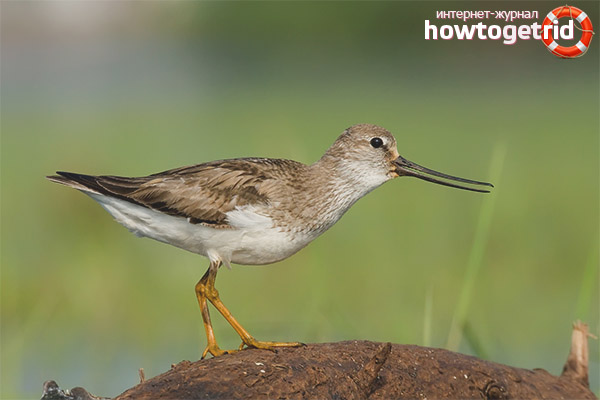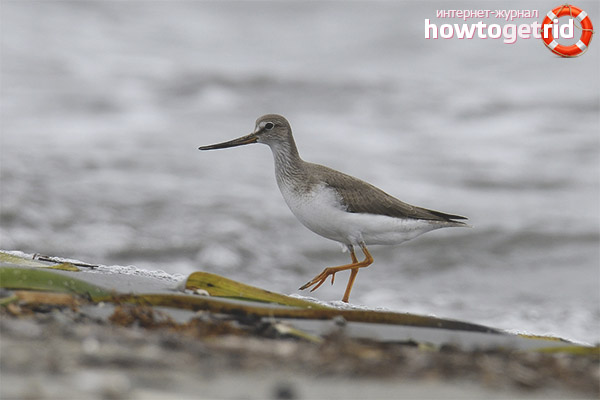The content of the article
Morodunka is a bird that is part of the family of snipe, charadriiformes. Her brothers in the family are: Curlew, herbalist, goldfinch, turukhtan, Chernysh, dunlin.
The size of the bird is on average 26 cm, the length of the opened wings is up to 45 centimeters, similar to a songbird. It weighs 60-125 grams, a little more than sparrows.
A long beak stands out, curved up and the size of two heads, black. In this, she differs from her brothers in appearance. The color of the bird is not bright, similar to the other snipe. The back and wings are brown or dark brown. The abdomen is often white, sometimes with a brown or brown tint. The tail is gray. The plumage at the tip of the wings and tail is much darker, brown, even closer to black.
The mussel has long legs of yellow color, the ends are black, on the surface of the metatarsus are shields. There are membranes, more pronounced between the middle and outer fingers. The neck is medium, the tail extends and looks very nice during the flight of the bird. Light eyebrows.
There are no differences in coloration between male and female. In summer, birds have two black stripes on their backs that disappear after they shed. In winter, the color is solid, almost the same as in summer. Plumage does not have bright colors. Only the hatched chick has a downy "outfit", similar to the carrier, but yellowish or more brown. Young growth on top has a darker color - brown, the ends of the feathers are ocher or red. The bird is very quick, can dramatically change the trajectory of movement.
Food
They feed mainly on animal food. Stones can eat, but birds need them only to improve grinding and digestion of food in the stomach. They eat insects, for example, terrestrial and aquatic beetles (swimmers). Also love to eat grubs. Of the aquatic inhabitants, they feed on crabs, mollusks, crayfish, spiders and worms; they can also look for them in the ground. When birds eat, they gather in large numbers. Become paws in the water, where shallow, and catch the victim. The beak is lowered into the pond at an angle and driven there from side to side. In addition to food of animal origin, algae and seeds are consumed. When a little Morodka catches a sufficiently large prey, it rinses it in water, and then eats it. On land, he searches for food by piercing sand along the length of his beak.
Breeding
It is in the spring that the little birds make a loud noise, but this does not mean that there is always a lot of noise from them. Just during the mating season, all species of birds are excited and behave loudly. The male, inviting the female, stands on the shore of the reservoir, raises its tail, trembles with its body and wings, while its beak is open.
Winged are very peaceful, easily get along with other species of birds. They nest on the ground, dig small holes about three centimeters in depth and less than ten in width. They are lined with leaves, moss, reeds, branches, tree bark, grass and other forest debris. Look for places where the nests will be invisible. Usually they are hidden in terrestrial vegetation. You can stand a few centimeters from the nest and not notice it and the bird that is there.
In May-June, egg laying is full. In pairs, two to five eggs appear, one brood. Only with loss of masonry can a female lay eggs again. They are pear-shaped in shape, the color is from buffy to brown, or gray with brown spots. Hatch them in turn, the male sits even more than the female.It lasts about three weeks, then chicks appear. First offspring are very helpless. Growth is fast, so parents have to bring them a lot of food. The female leads the chicks to the water, where they will be invisible to predators and safe. There they learn to swim, in danger they can dive or swim away at a distance. They begin to fly from about three weeks. This happens within two months, after which the chicks become independent.
Habitat

Habitat - Eastern Europe, forest-tundra and forest zone. They meet a Morodka also in Siberia. It lives where there is a large amount of vegetation. Most birds can be found on the north side of forests. He likes to settle along rivers, lakes and swampy shores of various reservoirs, where there are drifts of fin, flood meadows. Often found in small puddles that form on the banks of water bodies. Choose the area around the lakes so that there are places without grass, marshy, with silt or peat.
Rarely sit down on trees, if they sit down, then on willow bushes. They can live far from rivers and seas, but this is not very common. It is a migratory bird.
For the winter, in July - the end of September flies to Asia, Africa, Australia. Lives there on silty shores.
Death threat
Interesting Facts
There are several interesting facts from the life of the morodunks:
- They “make friends” with other birds; in the places of nesting they are often found together with a lapwing, a lieutenant, a spindle-tree, and a fifi.
- The voice is similar to curlew, but softer. Sounds consist of two to five syllables. When a bird is frightened, it publishes: “after all.” The song of the male during the mating season: “krruuu-krrruuu”, these sounds are quite loud. He publishes it flying low above the ground, bowing his head and spreading his wings wide.
- In Russia and Belarus is listed in the Red Book.
Video: Morodka (Xenus cinereus)










Submit